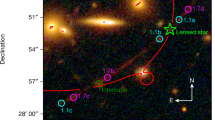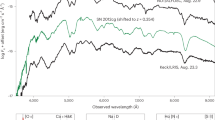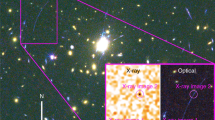Abstract
The concordance cosmological model predicts that galaxy clusters grow at the intersection of filaments that structure the cosmic web and extend tens of megaparsecs. Although this hypothesis has been supported by the baryonic components, no observational study has detected the dark matter component of the intracluster filaments (ICFs), the terminal segment of the large-scale cosmic filaments at their conjunction with individual clusters. We report weak-lensing detection of ICFs in the Coma cluster field from the ∼12-deg2 Hyper Suprime-Cam imaging data. The detection is based on two methods, the matched-filter technique and the shear-peak statistic. The matched-filter technique yields detection significances of 6.6σ and 3.6σ for the northern and western ICFs at 110° and 340°, respectively. The shear-peak statistic yields detection significances of 3.1σ and 2.8σ for these ICFs. Both ICFs are highly correlated with the overdensities in the weak-lensing mass reconstruction and are well aligned with the known large-scale (>10 Mpc) cosmic filaments associated with the Coma supercluster.
This is a preview of subscription content, access via your institution
Access options
Access Nature and 54 other Nature Portfolio journals
Get Nature+, our best-value online-access subscription
$29.99 / 30 days
cancel any time
Subscribe to this journal
Receive 12 digital issues and online access to articles
$119.00 per year
only $9.92 per issue
Buy this article
- Purchase on Springer Link
- Instant access to full article PDF
Prices may be subject to local taxes which are calculated during checkout




Similar content being viewed by others
Data availability
The raw Subaru HSC imaging data used for the current study are publicly available. The processed mosaic images and data points in the article figures are available on request from the authors. Source data are provided with this paper.
Code availability
Our custom data processing codes are available on request from the authors.
References
Cautun, M., van de Weygaert, R., Jones, B. J. T. & Frenk, C. S. Evolution of the cosmic web. Mon. Not. R. Astron. Soc. 441, 2923–2973 (2014).
Kuchner, U. et al. Mapping and characterization of cosmic filaments in galaxy cluster outskirts: strategies and forecasts for observations from simulations. Mon. Not. R. Astron. Soc. 494, 5473–5491 (2020).
Rost, A. et al. The ThreeHundred: the structure and properties of cosmic filaments in the outskirts of galaxy clusters. Mon. Not. R. Astron. Soc. 502, 714–727 (2021).
Maturi, M. & Merten, J. Weak-lensing detection of intracluster filaments with ground-based data. Astron. Astrophys. 559, A112 (2013).
Colberg, J. M., Krughoff, K. S. & Connolly, A. J. Intercluster filaments in a ΛCDM Universe. Mon. Not. R. Astron. Soc. 359, 272–282 (2005).
Mahajan, S., Singh, A. & Shobhana, D. Ultraviolet and optical view of galaxies in the Coma supercluster. Mon. Not. R. Astron. Soc. 487, 4336–4347 (2018).
Malavasi, N. et al. Like a spider in its web: a study of the large-scale structure around the Coma cluster. Astron. Astrophys. 634, A30 (2020).
Williams, B. A. & Kerr, F. J. The distribution of the spiral galaxies in the direction of the Coma/A 1367 supercluster. Astron. J. 86, 953–980 (1981).
Fontanelli, P. The Coma/A1367 filament of galaxies. Astron. Astrophys. 138, 85–92 (1984).
Kim, K. T., Kronberg, P. P., Giovannini, G. & Venturi, T. Discovery of intergalactic radio emission in the Coma-A1367 supercluster. Nature 341, 720–723 (1989).
Gavazzi, G., Carrasco, L. & Galli, R. The 3-D structure of the Coma-A 1367 supercluster: optical spectroscopy of 102 galaxies. Astron. Astrophys. 136, 227–235 (1996).
Gregory, S. A. & Thompson, L. A. The Coma/A1367 supercluster and its environs. Astrophys. J. 222, 784–799 (1978).
Ahumada, R. et al. The 16th Data Release of the Sloan Digital Sky Surveys: First Release from the APOGEE-2 Southern Survey and Full Release of eBOSS Spectra. Astrophys. J. Suppl. S. 249, 3 (2020).
Galárraga-Espinosa, D. et al. Relative distribution of dark matter, gas, and stars around cosmic filaments in the IllustrisTNG simulation. Astron. Astrophys. 661, A115 (2022).
Dietrich, J. et al. A filament of dark matter between two clusters of galaxies. Nature 487, 202–204 (2012).
Jauzac, M. et al. A weak lensing mass reconstruction of the large-scale filament feeding the massive galaxy cluster MACS J0717.5+3745. Mon. Not. R. Astron. Soc. 426, 3369–3384 (2012).
Jauzac, M. et al. Growing a ‘cosmic beast’: observations and simulations of MACS J0717.5+3745. Mon. Not. R. Astron. Soc. 481, 2901–2917 (2018).
Ma, C., Ebeling, H. & Barrett, E. An X-ray/optical study of the complex dynamics of the core of the massive intermediate-redshift cluster MACS J0717.5+3745. Astrophys. J. 693, L56 (2009).
Eckert, D. et al. Warm–hot baryons comprise 5–10 per cent of filaments in the cosmic web. Nature 528, 105–107 (2015).
Hoekstra, H. How well can we determine cluster mass profiles from weak lensing? Mon. Not. R. Astron. Soc. 339, 1155–1162 (2003).
Osato, K., Liu, J. & Haiman, Z. \(\kappa\)TNG: effect of baryonic processes on weak lensing with IllustrisTNG simulations. Mon. Not. R. Astron. Soc. 502, 5593–5602 (2021).
Nelson, D. et al. The IllustrisTNG simulations: public data release. Comput. Astrophys. Cosmol. 6, 2 (2019).
Pillepich, A. et al. First results from the IllustrisTNG simulations: the stellar mass content of groups and clusters of galaxies. Mon. Not. R. Astron. Soc. 475, 648–675 (2018).
Springel, V. et al. First results from the IllustrisTNG simulations: matter and galaxy clustering. Mon. Not. R. Astron. Soc. 475, 676–698 (2018).
Nelson, D. et al. First results from the IllustrisTNG simulations: the galaxy colour bimodality. Mon. Not. R. Astron. Soc. 475, 624–647 (2018).
Naiman, J. P. et al. First results from the IllustrisTNG simulations: a tale of two elements - chemical evolution of magnesium and europium. Mon. Not. R. Astron. Soc. 477, 1206–1224 (2018).
Marinacci, F. et al. First results from the IllustrisTNG simulations: radio haloes and magnetic fields. Mon. Not. R. Astron. Soc. 480, 5113–5139 (2018).
Reblinsky, K., Kruse, G., Jain, B. & Schneider, P. Cosmic shear and halo abundances: analytical versus numerical results. Astron. Astrophys. 351, 815–826 (1999).
Dietrich, J. P. & Hartlap, J. Cosmology with the shear-peak statistics. Mon. Not. R. Astron. Soc. 402, 1049–1058 (2010).
Kratochvil, J. M., Haiman, Z. & May, M. Probing cosmology with weak lensing peak counts. Phys. Rev. D 81, 043519 (2010).
Maturi, M., Angrick, C., Pace, F. & Bartelmann, M. An analytic approach to number counts of weak-lensing peak detections. Astron. Astrophys. 519, A23 (2010).
Bard, D. et al. Effect of measurement errors on predicted cosmological constraints from shear peak statistics with Large Synoptic Survey Telescope. Astrophys. J. 774, 49 (2013).
Marian, L., Smith, R. E., Hilbert, S. & Schneider, P. The cosmological information of shear peaks: beyond the abundance. Mon. Not. R. Astron. Soc. 432, 1338–1350 (2013).
White, M. & Kochanek, C. S. Constraints on the long-range properties of gravity from weak gravitational lensing. Astrophys. J. 560, 539–543 (2001).
Bertin, E. & Arnouts, S. SExtractor: software for source extraction. Astron. Astrophys. 117, 393–404 (1996).
Bosch, J. et al. The Hyper Suprime-Cam software pipeline. Publ. Astron. Soc. Jpn 70, S5 (2018).
Shupe, D. L. et al. More flexibility in representing geometric distortion in astronomical images. In Proc. SPIE (eds Radziwill, N. M. & Chiozzi, G.) 84511M (SPIE, 2012).
Weaver, J. R. et al. COSMOS2020: a panchromatic view of the universe to z ~ 10 from two complementary catalogs. Astrophys. J. Suppl. S. 258, 11 (2022).
Markwardt, C. B. Non-linear least-squares fitting in IDL with MPFIT. In Proc. Astronomical Data Analysis Software and Systems XVIII ASP Conference Series (eds Bohlender, D. A. et al.) 251 (Astronomical Society of the Pacific, 2009).
Dahlen, T. et al. A detailed study of photometric redshifts for GOODS-South galaxies. Astrophys. J. 724, 425–447 (2010).
Jee, M. J. et al. Principal component analysis of the time- and position-dependent point-spread function of the Advanced Camera for Surveys. Publ. Astron. Soc. Pac. 199, 1403 (2007).
Jee, M. J. & Tyson, J. A. Toward precision LSST weak-lensing measurement. I. Impacts of atmospheric turbulence and optical aberration. Publ. Astron. Soc. Pac. 123, 596 (2011).
Finner, K. et al. MC2: Subaru and Hubble Space Telescope weak-lensing analysis of the double radio relic galaxy cluster PLCK G287.0+32.9. Astrophys. J. 851, 46 (2017).
HyeongHan, K. et al. Discovery of a radio relic in the massive merging cluster SPT-CL J2023-5535 from the ASKAP-EMU Pilot Survey. Astrophys. J. 900, 127 (2020).
Finner, K. et al. Exemplary merging clusters: weak-lensing and X-ray analysis of the double radio relic, merging galaxy clusters MACS J1752.0+4440 and ZWCL 1856.8+6616. Astrophys. J. 918, 72 (2021).
Cho, H. et al. Multiwavelength analysis of A1240, the double radio-relic merging galaxy cluster embedded in an ∼80 Mpc-long cosmic filament. Astrophys. J. 925, 68 (2022).
Finner, K. et al. Hubble Space Telescope and Hyper-Suprime-Cam weak-lensing study of the equal-mass dissociative merger CIZA J0107.7+5408. Astrophys. J. 942, 23 (2023).
Dawson, W. A. et al. The ellipticity distribution of ambiguously blended objects. Astrophys. J. 816, 11 (2016).
Mandelbaum, R. et al. GREAT3 results - I. Systematic errors in shear estimation and the impact of real galaxy morphology. Mon. Not. R. Astron. Soc. 450, 2963–3007 (2015).
Hong, S. E. et al. Weak-lensing mass reconstruction of galaxy clusters with a convolutional neural network. Astrophys. J. 923, 266 (2021).
Kaiser, N. & Squires, G. Mapping the dark matter with weak gravitational lensing. Astrophys. J. 404, 441 (1993).
Acknowledgements
M.J.J. acknowledges support for the current research from the National Research Foundation (NRF) of Korea under the programmes 2022R1A2C1003130 and RS-2023-00219959.
Author information
Authors and Affiliations
Contributions
K.H. reduced the data, measured WL signals and filaments and wrote the manuscript. M.J.J. designed the research, created the reduction pipeline, coded the filament detection filter and wrote the manuscript. S.C. provided the mass reconstruction based on a convolutional neural network. H.C. identified the filaments based on the Coma galaxy distribution.
Corresponding author
Ethics declarations
Competing interests
The authors declare no competing interests.
Peer review
Peer review information
Nature Astronomy thanks Smriti Mahajan and the other, anonymous, reviewer(s) for their contribution to the peer review of this work.
Additional information
Publisher’s note Springer Nature remains neutral with regard to jurisdictional claims in published maps and institutional affiliations.
Extended data
Extended Data Fig. 1 WL S/N per physical area variation with the lens redshift.
Red solid line is the lensing efficiency β. Blue solid line is the WL S/N per physical area (λ) normalized by the value at \(z=0.5\). While the lensing efficiency is reduced approximately two orders of magnitude as the lens redshift decreases from z = 0.5 to the Coma redshift (z = 0.023\()\), the net WL S/N per physical area at the lens redshift increases approximately by a factor of three. This net gain is due to the combined effect of the higher score density \(n\) and lower LSS noise \({\sigma }_{{LSS}}\) per physical area at the Coma redshift. Here we assume that the purity \(\eta\) is the same across the lens redshift. In fact, \(\eta\) is also expected to be higher at the Coma redshift because of the proximity.
Extended Data Fig. 2 Matched-filter detection of the ICFs in the Coma cluster.
Black (red) solid line represents the tangential (cross)-shear component. Dark shade indicates the shot noise (equation 5). Light shade includes both the shot noise and the noise due to the LSS effect. Three ICFs (N, SE and W) are detected with a significance level higher than 3\(\sigma\). The cross-component crosses zero at these locations.
Extended Data Fig. 3 Matched-filter detection with a mock filament-cluster configuration.
Top Left: Mock convergence map with two filaments and an NFW halo displayed in log scale. Mock filaments are oriented at 10° and 70° with an NFW halo at the centre. The linear mass density of the filament mf = 1.2 × 1014 M☉Mpc−1 and the halo mass M200 = 8 × 1014 \({M}_{\odot }\) are motivated by our measurements in Coma. Whiskers show the resulting WL shear. Inner and outer yellow circles indicate r = 1 and 2.8 Mpc, respectively. Top Right: Black (red) solid line indicates the tangential (cross)-component \({\Gamma }_{+}({\Gamma }_{\times })\). The tangential-shear component is also shown in the left panel (black solid) in polar coordinates. Bottom: Same as the top panels except that another M200 = 8 × 1014 \({M}_{\odot }\) halo is placed (white arrow) at θ = 120°, ∼1.2 Mpc apart from the centre. The tangential component \({\Gamma }_{+}\) is sensitive to the filamentary mass structure and peaks at the correct angles. Although the off-centre halo gives rise to a small peak at θ = 120°, its height is much weaker than those arising from the real filamentary structures. Here we show the version that does not include intrinsic shape noise for illustration purposes. With the inclusion of the shape noise, the tangential-component peak due to the halo is below our detection threshold.
Supplementary information
Supplementary Information
Supplementary Figs. 1–3 and Table 1.
Supplementary Data 1
Source data for Supplementary Figs. 2 and 3 and Table 1.
Source data
Source Data Fig. 1
Source data.
Source Data Fig. 2
Source data.
Source Data Fig. 3
Source data.
Source Data Fig. 4
Source data.
Source Data Extended Data Fig. 1
Source data.
Source Data Extended Data Fig. 2
Source data.
Source Data Extended Data Fig. 3
Source data.
Source Data Extended Data Table 1
Source data.
Rights and permissions
Springer Nature or its licensor (e.g. a society or other partner) holds exclusive rights to this article under a publishing agreement with the author(s) or other rightsholder(s); author self-archiving of the accepted manuscript version of this article is solely governed by the terms of such publishing agreement and applicable law.
About this article
Cite this article
HyeongHan, K., Jee, M.J., Cha, S. et al. Weak-lensing detection of intracluster filaments in the Coma cluster. Nat Astron 8, 377–383 (2024). https://doi.org/10.1038/s41550-023-02164-w
Received:
Accepted:
Published:
Issue Date:
DOI: https://doi.org/10.1038/s41550-023-02164-w



